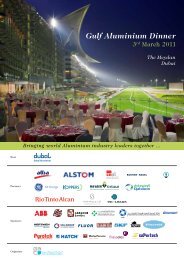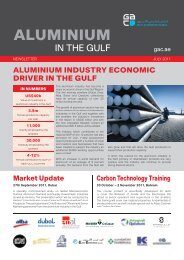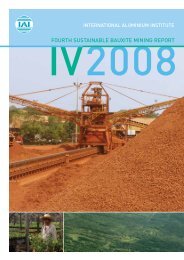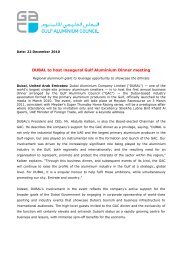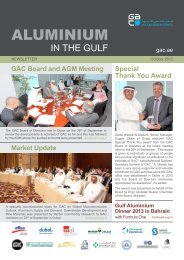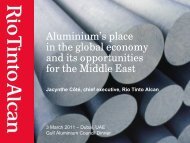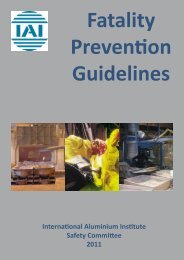ALUMINIUM - Gulf Aluminium Council
ALUMINIUM - Gulf Aluminium Council
ALUMINIUM - Gulf Aluminium Council
You also want an ePaper? Increase the reach of your titles
YUMPU automatically turns print PDFs into web optimized ePapers that Google loves.
<strong>ALUMINIUM</strong>IN THE GULFgac.aeNEWSLETTER May 2013HRH, The Prime Minister ofBahrain receives GAC BoardHRH, The Prime Minister of Kingdom of Bahrain, PrinceKhalifa bin Salman Al Khalifa received the Board ofDirectors and Secretary General of the <strong>Gulf</strong> <strong>Aluminium</strong><strong>Council</strong> on the 21st April 2013 at the Gudaibiya Palace.GAC awarded the HRH, The Prime Minister, GAC’sspecial recognition for his pioneering role in establishingthe <strong>Aluminium</strong> industry in Bahrain which was the first inthe <strong>Gulf</strong> region. HRH expressed his support to GAC andthe industry in general which now constitutes one of themain driver for the economy in the region, creating jobs fornationals and encouraging the formation of support industry.<strong>Gulf</strong> <strong>Aluminium</strong> Dinner 2013The <strong>Gulf</strong> <strong>Aluminium</strong> Dinner on the 20th April 2013 in Bahrain will be remembered as a very special occasion, ascommented by those attended, held at the recently constructed Bahrain National Theatre. The guests representing the<strong>Gulf</strong> <strong>Aluminium</strong> industry executives in addition to world aluminium organisation’s and downstream industries, suppliers,service providers, power generation manufacturers invited for an opportunity to strengthen such positive relationship.Around 250 selective guests attended this prestigious dinner which takes place annually in one of the G.C.C countries.
HRH, The Prime Minister of Bahrain receives GAC BoardSponsors lunch - Bahrain<strong>Gulf</strong> <strong>Aluminium</strong> <strong>Council</strong>’s Board of Directors hosted a special lunch to the sponsors of the <strong>Gulf</strong> <strong>Aluminium</strong> Dinneron 20th April at the Bahrain Capital Club. 35 senior representatives from the aluminium producers, power generation,manufacturers, suppliers, service providers attended the lunch for meeting the Chief Executives of senior members of thealuminium industry in the region.
MARKET UPDATEUS Midwest Premiums - The method behind the madnessBy Mike Southwood - CRUOne question that has been constantly asked of late isthat are premiums rising when the LME price continuesto struggle, and the global market surplus remainsexcessive? The average spot Midwest Premium beginJanuary 2010 at 5.5¢/lb but by the end of the year thepremium stood at 11¢/lb. This rise is especially curiousbecause between 2010 and 2012, LME aluminium stocksin Detroit rose from 900,000 t to an all-time high of 1.49mt. Under typical circumstances, this would have putdownward pressure on the premium, as it would imply thatmore metal was available to the market. As of April 2013,the average spot Midwest Premium was 11.75¢/lb.So what caused this doubling of the Midwest Premium overthe span of three years? Underlying the Midwest Premiumis the ongoing market deficit present in the USA, and howthis deficit is satisfied. As in the past, most of the deficitduring 2010 -2012 was satisfied by primary imports fromCanada. However, during this time, while the US deficitincreased, imports from Canada fell. Unwrought importsfrom Canada totalled 2.1 mt in 2009, but totaled only 1.84mt in 2011, and remained flat y-o-y in 2012. And as can beseen in the chart, an inverse relationship between lowerimports from Canada and higher Midwest Premiums hasbeen in evidence from 2009. In addition, imports fromSouth American countries, such as Brazil, Argentina andVenezuela fell during 2010-2012. As a result, the USA hadto compete for metal from farther afield, such as Russiaand the GCC. The need to compete for metal from theseregions placed upward pressure on the Midwest Premiumas well as helping to raise premiums on a global level.However, net imports into the USA alone could not satisfythe market deficits in 2010-2012. Therefore, warehousestocks, both LME and off-exchange, would be neededto satisfy demand. This was another source of upwardpressure. During 2009, long-term warehouse financedeals suddenly became a very popular tool for financiers.There was an ample supply of metal due to the downturn indemand, which created a large market contango, and thefinancing of this metal was made possible by historicallylow interest rates. These deals continued to be popular in2010 and through 2012. So while warehouse stocks werebuilding in Detroit, a majority of these stocks were tied upin long-term deals and thus ‘unavailable’ to the market.This created an artificial tightness in the physical market,which compounded the US deficit situation and pushedpremiums higher. It is important to note that these dealsrely on low interest rates and a healthy contango in orderto be profitable. So if either of these variables cease toexist, financing deals would likely start to unwind. CRUdoes not expect interest rates in the USA to rise until 2014at the earliest, however, so unless the market goes intobackwardation, financing deals look set to continue.Detroit LME aluminium stocks& Midwest PremiumData: CRU, LMEUSA imports of unwrought aluminiumData: GTIS, CRUDetroit aluminium cancelled warrants& Midwest premiumData: CRU, LMEContinued page 4
As competition for metal units increased, LME warehousesin Detroit started offering higher cash incentives toproducers to lure their metal into their warehouses. Thesecash incentives have essentially created a ‘floor’ under theMidwest Premium, as they are in direct competition withone another, and the premium needs to be high enoughto entice metal away from the warehouses and back intothe market. In 2010, incentives were as low as $60/t (2.7¢/lb), but rose to $120/t (5.4¢/lb) by the end of the year.In 2011, incentives were offered around $150/t (6.8¢/lb),and in 2012 were as high as $180/t (8.2¢/lb). As of April2013, these incentives had risen to $220/t (10.0¢/lb). Allof these factors helped the Midwest premium to increasefrom 7.5¢/lb to 11.0¢/lb in 2012.However, there was one additional factor whichexerted significant influence on the Midwest premiumin 2012 that was not as prevalent in past years -cancelled warrants of LME aluminium in the Detroitwarehouses. As illustrated in the chart, there is no denyingthe correlation between the massive increase in cancelledwarrants that occurred during 2012 and the increase in theMidwest premium. CRU began to raise awareness aboutthis phenomenon back in 2011, when cancelled warrantsrose from 30,000t to 300,000t in a matter of months.At the end of 2012, cancelled warrants in Detroit roseto over 1,000,000t. At the end of April, they totalled942,400t, accounting for 71% of total LME <strong>Aluminium</strong>stocks in those warehouses. The extremely high levelof cancelled warrants created long queues for deliveryof metal, despite the change in LME rules in April 2012which doubled the daily outflow rate to 3,000t. Currently,the wait time for delivery in Detroit is about 15 months.During this time, the LME warehouse owner collects fullrent on every tonne of <strong>Aluminium</strong> in the queue from theconsumer. Until these conditions are alleviated, thissituation will continue to exert upward pressure on theMidwest Premium.In conclusion, the USA is expected to continue to havea structural market deficit which will need to be satisfiedby primary imports and warehouse stocks. Importsfrom locations further afield will continue to keep thefreight component of the Midwest Premium significant.However, the situation at the LME warehouses in Detroit(financing deals, incentives, and cancelled warrants)will likely be the main driver of the Midwest Premium in2013, which we expect will remain at an elevated level.<strong>Gulf</strong> <strong>Aluminium</strong> Dinner 2013
FACTS AND FIGURES<strong>Gulf</strong> <strong>Aluminium</strong> Production Capacity 2012 (tonnes per year)Product Bahrain UAE Saudi Arabia Qatar Oman Kuwait TotalPrimary 890,000 (A) 1,800,000 (B) 740,000 600,000 375,000 - 4,405,000Secondary 452,000 365,,000 (C) 565,000 15,000 208,000 26,500 1,631,500Extrusion 6,000 192,000 170,000 15,000 18,000 26,500 427,500Roll Product 165,000 85,000 (D) 380,000 - (B) 160,000 - 790,000Cables + Wire 225,000 20,000 - - 30,000 - 275,000Casting 50,000 68,000 15,000 - - - 133,000Powder 6,000 - - - - - 6,000Source: VariousGAC not responsible for any inaccuracyA. Does not include Emal 2 (500,000 tonnes)B. Being commissionedC. Include Ma’aden Rolling MillD. Under constructionHR DevelopmentsElectrolysis Course in Dubai45 senior operators and First linesupervisors attended the course,specially developed for GAC smelterscombined with a visit to Dubal.Advanced Electrolysis Coursein Dubai55 superintendents and managers for thesmelters in the <strong>Gulf</strong> got together for a oneday Potroom management course anddiscussion in Dubai.Marketing Fundamentals andLME in Doha27 Marketing staff from the smelters andmajor downstream companies attendedthe two days Marketing Fundamentals andLME (London Metal Exchange) Operationand Marketing course, conducted by BrianWoodbridge in Doha, Qatar.The two day course was especiallydeveloped for GAC.
Fire prevention guidelinesFUELFIREOXYGENClassification of FireClass AClass BClass CClass DClass FFire Risk AssesmentThe causes of Fire -The Fire TriangleFor a fire to start it isrequired to have a 3elements to make upthe fire which are Heat,Fuel and Oxygen. If oneelement is removed thefire will be put off.Fire which involves solid materials suchas wood, paper, coal, etc.Fire which involves liquid materials suchas petrol, diesel, oil, greases and paint.Fire which involve gases or liquefied gases,such as methane, propane and butane.Fire which involves liquid metals such asaluminium, sodium, and potassium.Fire which involve cooking fat.It is very important to know which fire we are dealing withand which material is involved in the fire in order to usethe right method of extinguishing the fire.News<strong>Gulf</strong> Extrusions awardedISO/TS 16949 certification for itsDubai extrusion facility<strong>Gulf</strong> Extrusions, manufacturer of extrudedaluminium products, announced that it hasattained the ISO/TS 16949 certification forits Dubai extrusion facility.<strong>Gulf</strong> Extrusions is therefore well-positionedto meet the demand for aluminium from theglobal automotive markets.OAPIL to expandproduction capacityOman <strong>Aluminium</strong> Processing Company(OAPIL), manufacturers of aluminium rodand overhead line conductors planning toexpand its production capacity by 75,000metric tonnes per annum, current production48,000 metric tonnes per annum.OAPIL is a joint venture between OmanCables Industry and Takamul Investment.STEP 1STEP 2STEP 3STEP 4STEP 5Identify the fire hazardsIdentify the people who might beharmed and howEvaluate the risk and decideon precautionsRecord the significant findingsReview and update as necessarySilicon smelter in Abu DhabiDubai based Al Braik Investments said itis planning to set up silicon smelter in AbuDhabi, the first facility of its kind among <strong>Gulf</strong>Arab countries.EventsJuly 2 - 4, 2013Shanghai New InternationalExhibition Centre, China5 - 7 November 2013, Abu Dhabi, U.A.EOrganised by EMAL




